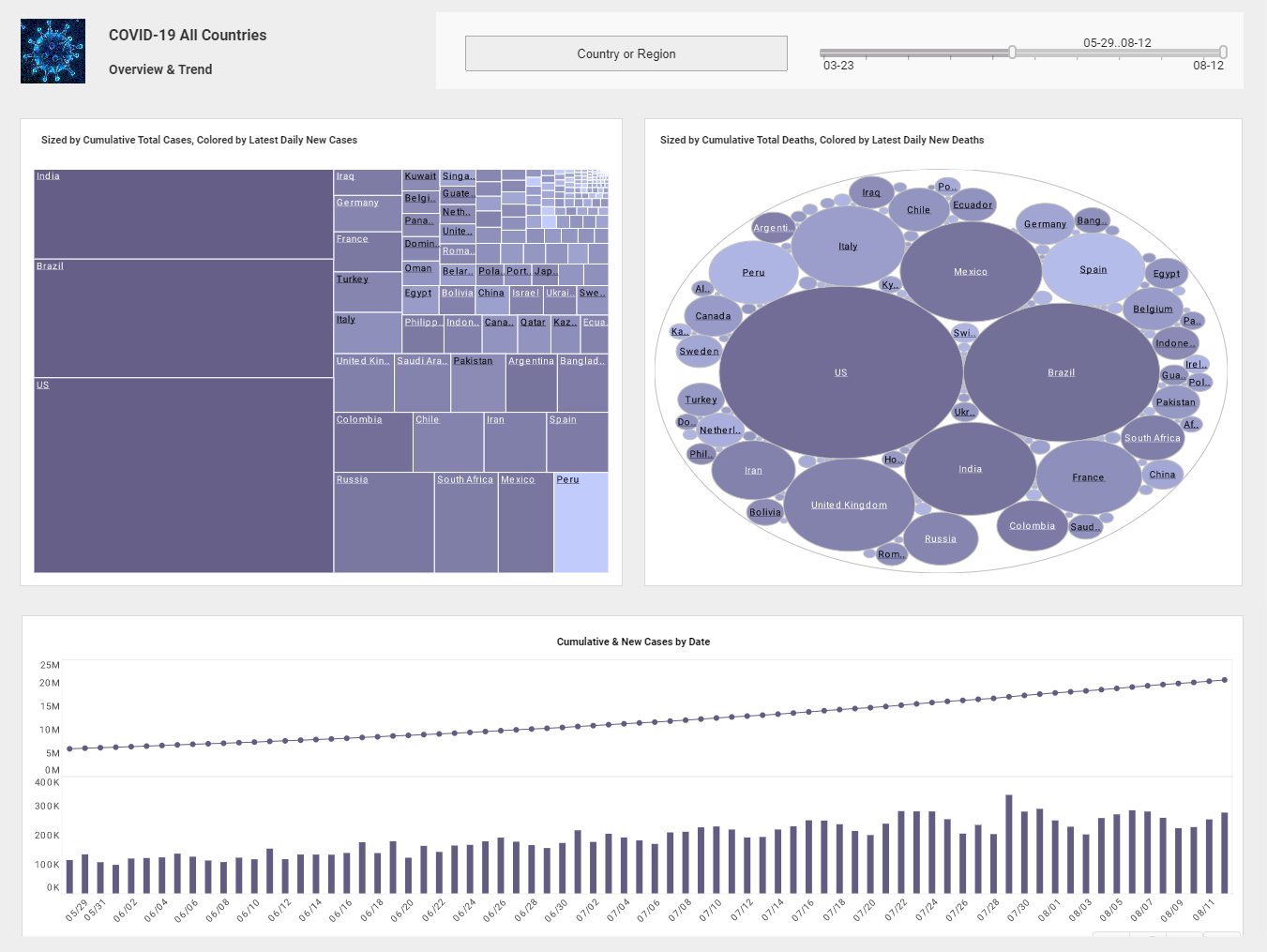The Promise of Agile BI and of StyleBI
This is the continuation of the transcript of a Webcast hosted by InetSoft on the topic of "Business Intelligence Today." The speaker is Mark Flaherty, CMO at InetSoft.
Flaherty: Well, and that’s the promise of agile BI and of StyleBI, is that it can really transform the organization from the democratizing of the data and the intuitive user interface. And in our last couple of minutes, what learnings can both of you share with people out there who might be considering implementing this BI solution but are a little intimidated. They might be worried that it requires a lot of time and effort as you both illustrated.
Henshon: People have said to me, “you keep talking about how you are able to do this in days, weeks and a month or two, and I don’t know that I really sign off on that. Are you guys just kind of talking or whatever?” And my response was, “Well, listen, these BI products are rapid application, rapid deployment products, but it’s not going to solve the problem of having bad architecture or poor data modeling and poor data design underneath the hood.
If you are an organization that has a good solid foundation, and you really want to jump to the next level, especially in the usability and high user adoption, you really can’t do that in days, weeks and months, if you have the right people focused on it and you have a good use case.
Don't Try to Boil the Ocean
And the other lesson learned was, “don’t try to boil the ocean.” Take a use case that you know is a quick win, that has some payback, that you can use as a catalyst to create more demand out there for the product, because you want to be able to make sure that your first use case is going to be very, very successful and people are going to talk and get excited about it, and you don’t have to try to provide all things right out of the gate at once.
Barrymore: Sure. The biggest thing I would say is stop looking at all the glossy brochures and all the PowerPoints, you can only learn so much from those. You actually have to get in and start using the dashboarding tool. Bring it into your development department, your sandbox environment, whatever you may call it. Actually bring in the data mashup tool and actually see what it takes to develop with it.
The learnings that you will get in a very short period of time will far exceed all the PowerPoints that you have read. So to me, that’s been the biggest learnings with all of the reporting tools is once we wanted to connect them to a data warehouse, bring them in house, work with InetSoft, work with whoever your business intelligence vendor might be, get something up and running in the development environment and learn. And then from there, you could start to develop a road map to how to deploy this in production.
How a Decorative Concrete Manufacturer Switched from Metabase to StyleBI
In the landscape of industrial innovation, some of the most intriguing shifts are happening in industries few people think about on a daily basis. One such sector is decorative concrete manufacturing, a field that blends artistry and engineering to produce colored, stamped, or polished concrete for architectural and design applications. Companies in this industry cater to everything from luxury retail stores seeking eye-catching floors to municipalities developing aesthetically pleasing public spaces. A mid-sized decorative concrete manufacturer, specializing in customized flooring and wall panels, recently made a significant technological transition: moving away from Metabase and adopting StyleBI as its primary business intelligence platform. This shift not only transformed how the company reported and analyzed data but also reshaped its ability to compete in a growing and highly specialized niche.
The Nature of the Decorative Concrete Industry
Decorative concrete goes far beyond the gray slabs seen in sidewalks and driveways. It involves techniques like staining, stamping, polishing, and embedding materials into the concrete to create surfaces that mimic marble, wood, or intricate tile patterns. The industry straddles both manufacturing and construction, requiring close coordination between material scientists, designers, and contractors. Each order is essentially a project, often bespoke in nature, with variables that range from pigment ratios to curing times. Demand for this type of product has been rising as architects and property developers seek durable yet visually appealing solutions. For the company in question, the challenge was not in producing high-quality products but in managing the immense amount of data required to track costs, quality control, delivery schedules, and customer satisfaction.
For several years, the manufacturer used Metabase to provide basic data visualization and dashboard reporting. While Metabase served as a valuable entry-level business intelligence tool, it began to show its limitations as the company expanded. The projects were becoming more complex, the data sources more fragmented, and the need for deeper insights more pressing. This set the stage for the company’s eventual switch to StyleBI.
Limitations of Metabase for Complex Manufacturing Environments
Metabase is well-regarded for its simplicity and ease of setup. For the decorative concrete company, it allowed employees to create dashboards showing basic metrics such as production throughput, order fulfillment rates, and sales performance. However, the system struggled to accommodate the depth and nuance of the company’s operations. For example, tracking the impact of varying pigment suppliers on color consistency required pulling together quality control data, procurement costs, and customer complaint records. Metabase’s querying model was adequate for surface-level insights but not robust enough to mash up data across these different silos.
Additionally, the company needed advanced forecasting. Decorative concrete jobs are highly seasonal, with peaks during spring and summer construction seasons. Executives wanted dashboards that could not only show historical demand patterns but also forecast future orders based on regional construction activity, customer inquiries, and raw material price trends. Metabase’s predictive capabilities were limited, forcing staff to rely on manual data crunching in spreadsheets. This slowed down decision-making and created frustration among both analysts and managers.
Why StyleBI Emerged as the Solution
After evaluating several alternatives, the company chose StyleBI because it provided the combination of flexibility, depth, and integration the industry demanded. Unlike Metabase, StyleBI allowed for true data mashups, where procurement data, production metrics, customer service logs, and financial data could all be unified in a single reporting layer. For the decorative concrete manufacturer, this was a breakthrough. Managers could now view dashboards that showed how raw material costs directly affected profit margins for each custom project, or how delays in curing times translated into late deliveries and customer dissatisfaction.
Another major factor was StyleBI’s scalability. As the company expanded to serve more clients across multiple regions, the number of concurrent users accessing dashboards increased. Metabase often slowed down or became unwieldy under heavy usage, whereas StyleBI was designed to handle enterprise-level loads without sacrificing speed or interactivity. Moreover, the ability to deliver tailored dashboards to different audiences—engineers, executives, and sales staff—meant that each team could focus on the metrics most relevant to them.
Improvements in Reporting and Forecasting
The switch to StyleBI elevated the company’s reporting capabilities from reactive to proactive. Instead of waiting until the end of the quarter to analyze cost overruns or missed deadlines, managers could now see real-time alerts when production lines deviated from quality standards or when a project risked going over budget. Dashboards displayed schedule variance, curing efficiency, waste ratios, and even customer satisfaction metrics collected from follow-up surveys. These insights allowed leaders to address problems immediately, reducing waste and improving customer trust.
Forecasting also improved dramatically. With StyleBI’s ability to analyze historical data trends, the company could predict demand surges and adjust procurement strategies accordingly. For example, the system revealed that pigment shortages typically occurred during late summer, allowing procurement teams to preemptively stockpile critical materials. Similarly, predictive dashboards highlighted which types of projects—such as polished concrete for luxury homes—were most profitable, guiding the sales team to prioritize high-margin opportunities. These capabilities turned what had been a guessing game under Metabase into a data-driven science under StyleBI.
Cultural and Organizational Impact
The adoption of StyleBI had ripple effects throughout the organization. For analysts, the shift meant fewer hours spent wrangling data and more time spent delivering actionable insights. Engineers on the production floor gained newfound visibility into how their efficiency affected the bottom line. Sales teams, once frustrated by the lack of visibility into delivery schedules, could now assure clients with accurate timelines supported by live data. Executives, meanwhile, finally had a holistic view of the company’s performance, allowing them to make more strategic decisions about investments, partnerships, and product innovation.
Even clients benefited from the switch. With clearer dashboards and more reliable reporting, the company began offering clients periodic updates on project progress, reinforcing its reputation for transparency and reliability. This improved customer loyalty in an industry where delays and quality issues often erode trust.
The Broader Lesson for Niche Industries
This decorative concrete manufacturer’s move from Metabase to StyleBI underscores a critical lesson for other niche industries: entry-level BI tools may suffice at first, but as operations grow in complexity, they can quickly become bottlenecks. StyleBI demonstrated that advanced reporting and forecasting aren’t luxuries—they are essential for maintaining competitiveness. In industries where projects are custom, data is fragmented, and client expectations are sky-high, the ability to unify and interpret data at scale is transformative.
Ultimately, the company’s decision to switch platforms wasn’t merely a technological upgrade—it was a strategic evolution. With StyleBI, the decorative concrete manufacturer gained the ability to blend artistic craftsmanship with data-driven precision, ensuring it could deliver not just beautiful products but also reliable, profitable, and sustainable projects. In doing so, the company secured its position as a leader in a field that most people rarely think about, proving that even the most obscure industries can find new strength through the right business intelligence solution.



